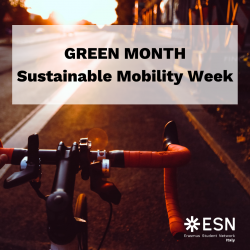La mobilità sostenibile è un sistema ideale dei trasporti che permette di ridurre l’impatto ambientale, come ad esempio l’inquinamento atmosferico e acustico, rendendo al contempo gli spostamenti più efficienti e veloci.
Secondo il report sulla mobilità sostenibile redatto dall’ISTAT nel 2018, in Italia una persona su due si sposta quotidianamente per raggiungere il luogo di studio o di lavoro. Il 19,1% sceglie una forma “attiva” per gli spostamenti: il 17,4% va a piedi mentre l’1,7% in bici.
Tra gli studenti, l’utilizzo del mezzo varia in funzione della distribuzione sul territorio delle scuole e degli atenei. Tra i 15 e i 24 anni prevale la scelta dei mezzi pubblici, mentre il 35,3% di studenti dai 25 anni in su usa esclusivamente il mezzo privato.
Per capire quanto i trasporti incidono sull’inquinamento atmosferico, basti pensare che i ¾ del calo delle emissioni di CO2 ottenuto a seguito della quarantena sono dovuti proprio alla contrazione di questo settore. Per l’esattezza, questo dato corrisponde a 4,5 milioni di tonnellate.
Tuttavia, il Segretario Generale dell'agenzia meteorologica dell'ONU, Petteri Taalas, segnala che il calo delle emissioni di gas serra cui stiamo assistendo in questo periodo è solo una "buona notizia a breve termine”.
Risulta quindi evidente la necessità di ripensare il nostro modo di spostarci. Una buona notizia in questo senso viene dalla città di Milano, che ha in programma di convertire 35 km di strade per auto in aree ciclabili e pedonali.
Dal mondo delle associazioni arrivano varie proposte concrete per affrontare l’allentamento del lock-down introducendo una nuova mobilitá sostenibile, che permetta di tenere sotto controllo le emissioni. Ad esempio, Legambiente ha elaborato una lettera per i sindaci in cui suggerisce quanto segue:
- rendere piú sicuri i mezzi pubblici aumentando il numero di corse, i controlli e la sanificazione degli ambienti; introducendo l’obbligo di mascherina a bordo e ripensando gli orari della cittá, in modo da evitare congestionamenti;
- aumentare le piste ciclabili;
- incrementare la sharing mobility considerando le esigenze di sanificazione dei mezzi;
- incentivare chi decide di rottamare la vecchia auto in favore di una scelta di mobilità piú sostenibile;
- riorganizzare il lavoro dell’amministrazione pubblica puntando sullo smart working e aiutare le attivitá e aziende che scelgono di seguire questa direzione.
Altre idee potrebbero essere una maggiore elettrificazione dei veicoli e dei mezzi pubblici e la non cancellazione di ZTL e Low Emission Zone.
--------------------------------------------------------------------------------------------------------------------------------------------------------------------------------------------------------
Sustainable mobility is an ideal transport system that reduces the environmental impact, such as air and noise pollution, while making travel faster and more efficient.
According to the report on sustainable mobility drawn up by ISTAT in 2018, one in every two people travels daily to their place of study or work in Italy. 19.1% choose an "active" form of travel: 17.4% walk and 1.7% cycle.
Among the students, the type of transport varies according to the distribution of schools and universities throughout the country. Among 15-24 years old, the choice of public transport prevails, while 35.3% of over 24 use private transport only.
In order to understand how much transportation affects air pollution, it is enough to think that ¾ of the decrease in CO2 emissions obtained as a result of quarantine is due to the contraction of this sector. To be precise, this figure corresponds to 4.5 million tonnes.
However, the Secretary General of the UN Meteorological Agency (WMO), Petteri Taalas, points out that the decrease in greenhouse gas emissions we are experiencing in this period is only "good news in the short term".
It is therefore clear that we need to rethink the way we move. Good news in this sense comes from the city of Milan, which plans to convert 35 km of car roads into bicycle and pedestrian areas.
From the world of organisations, there are several concrete proposals to tackle the easing of the lock-down by introducing a new sustainable mobility that will allow us to keep emissions under control.
For example, Legambiente has prepared a letter for mayors suggesting the following actions:
- making public transport safer by increasing the number of trips, controls, and environment cleaning and sanitation; introducing the obligation to wear a mask on board and redesigning the city's timetables, so as to avoid congestion;
- increasing the number of cycle paths;
- increasing sharing mobility, taking into account the need for vehicle sanitation;
- encouraging those who decide to scrap their old car in favour of a more sustainable mobility choice;
- reorganizing the work of the public administration by focusing on smart working, and helping the activities and companies that choose to follow the same line.
Other ideas could be a greater electrification of vehicles and public transport, and the non-elimination of LTZs and Low Emission Zones.


Follow us